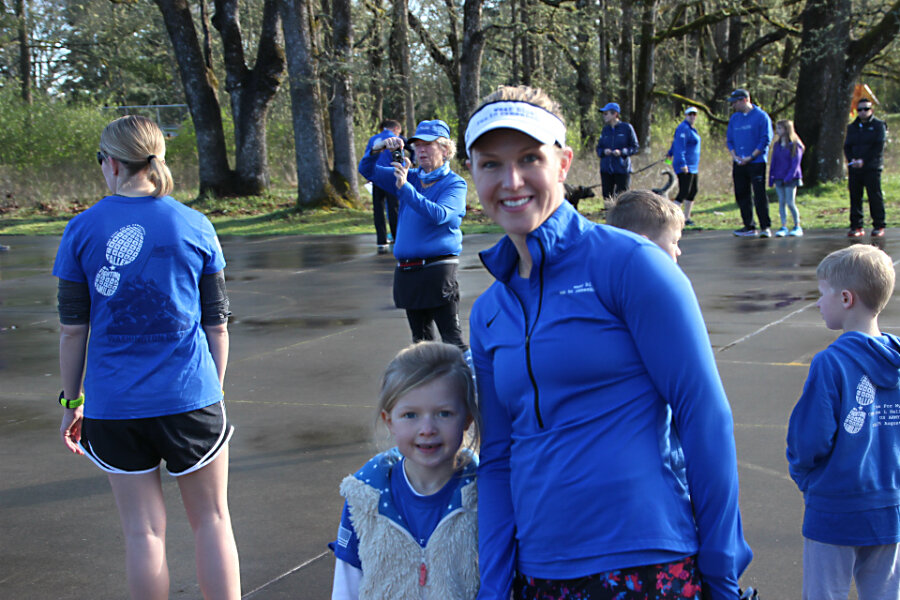After losing her husband, this military wife laced up sneakers with others
| DuPont, Wash.
Understandably, her grief was overwhelming.
Lisa Hallett, with her youngest of three small children just a week old, got the worst news a military wife can receive. Her husband, John Hallett, her best friend since she was 5 years old, was killed in action while serving in Afghanistan.
But rather than wallow, rather than pull into a dark world of grief, Ms. Hallett did the unexpected. She reached out and found rescue by lacing up her sneakers.
“Running was always the way I dealt with the challenges of military life,” Hallett says. “I've always loved running.”
Three days after her husband's death on Aug. 25, 2009, she went on a three-mile run, desperately trying to cope with her grief. Within six months, Hallett had helped form a running club that now has 15,000 members across America. It's called Wear Blue: Run to Remember.
Helping others cope with the death of a family member in the military, helping them climb out of despair, has become her mission. Wear Blue is also about helping military families cope with a spouse or child being away on assignment.
2009 was a tough year for Joint Base Lewis-McChord in Washington, where Hallett's husband had been stationed. Forty-one soldiers with the 5th Brigade at JBLM were killed in action overseas. Initially, Hallett began running with a few friends who were also coping with the loss of a loved one, or with one away on assignment.
“We were finding the power of the run is sort of a solace and strength throughout the deployment,” she says. “But [then] we took the power of the run and we bound it with the power of community.”
And Wear Blue was born.
On every Saturday, runners across the country meet for a run wearing blue, commemorating those soldiers who have been lost. Before their run, they circle in a group, and the names of soldiers killed in action are called out.
In DuPont, a town near JBLM, between 100 and 200 runners join Hallett for a run every Saturday. There are three other Wear Blue chapters of similar size near military bases in the United States and 52 smaller ones. Members of the group also run at national events across the country wearing blue.
It's all about gathering to support and to remember.
“That's the power of community,” says Hallett, who is president of Wear Blue. “There are days you give strength, and there are days you get strength.”
Rachel Elizalde-Powell, whose brother was killed fighting in Iraq on Aug. 23, 2007, says she has been rescued by her involvement with Wear Blue.
“I started using running for coping and healing for me,” she says. “I had made my brother a promise that we would run when he came back from Iraq.”
Ms. Elizalde-Powell, who is now co-president of the JBLM chapter of Wear Blue, shares her story to help others bare their grief. She says she’s been helped by Hallett’s story.
“Lisa took a very hard challenge that was put in front of her and turned it into a very positive moment to be able to help others,” Elizalde-Powell says. “It's extremely inspiring.”
Hallett's message with Wear Blue is about moving past the grief.
“Wear Blue is getting beyond the death,” she says. “That's where people usually stop. It's getting back into the life. Wear Blue is all about celebrating the lives of these men and women. And when we celebrate, we're living the inspiration and the light that they lived. I love that.”
Krista Simpson, whose husband, Mike, died on May 1, 2013, after being wounded in Afghanistan, credits Wear Blue for helping her get past the grief and get her life back.
“Every time I think I'm not sure I can go another day without him, I look at Lisa and I think she keeps going and she's amazing athletically, spiritually,” Ms. Simpson says. “She's an inspiration.”
With her involvement with Wear Blue, Simpson's focus has shifted to helping others.
“I try to tell my story because it's important for people to hear,” she says. “It gives other people faith to keep going. It's a handshake you wish you didn't know. But when you know it, you have a good group with you.”
When Hallett's husband died, her children were ages 3 and 1, in addition to the infant.
“I recognized that they had lost their father,” she says. “That was an enormous sacrifice. But it wasn't fair for them to lose their mother to grief, too.”






